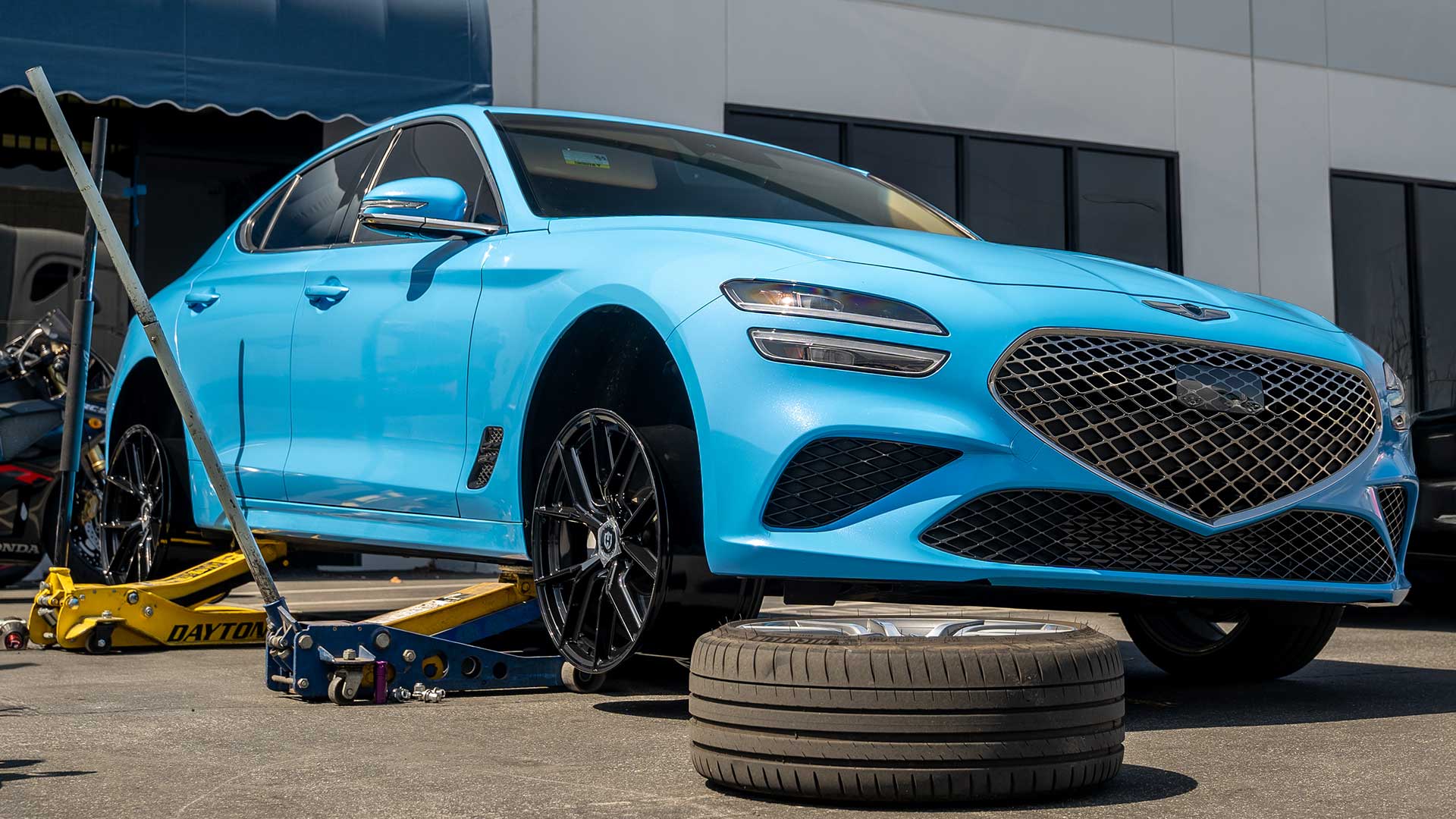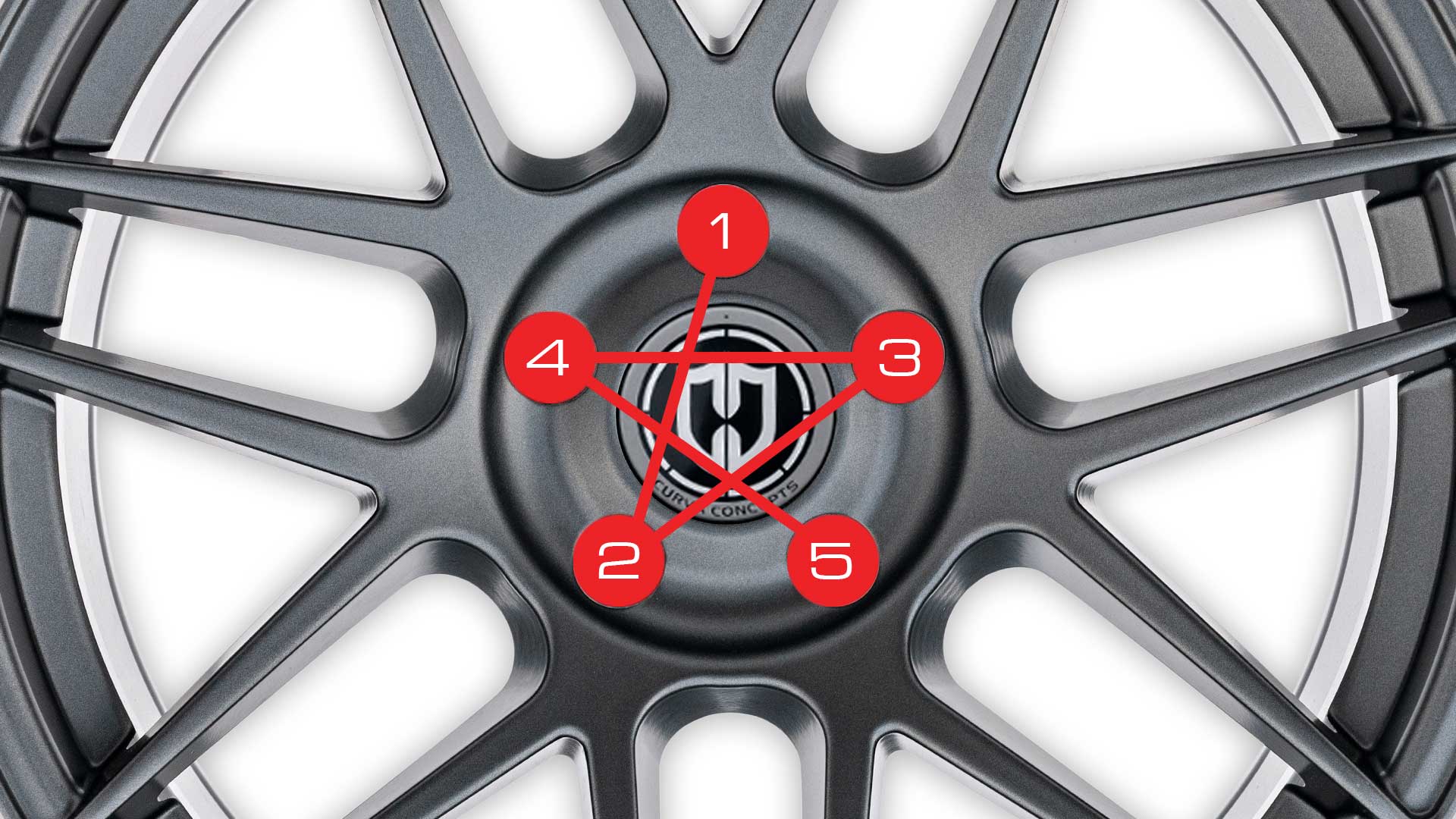Will These Lug Nuts Work? A Simple Guide to Wheel Hardware
Your new set of wheels was finally delivered. You opened them up, setting everything up for a test fit—when reality hit: “Will my existing lug nuts work?” We’ve seen too many people learn this lesson the hard way. Although it’s not the end of the world and really is a simple solution, proper wheel hardware isn’t just a minuscule detail; it’s the foundation of safe, reliable wheel fitment.
Understanding the different types of lug nuts or wheel bolts and their intended use case can be the difference between a smooth install and an absolute nightmare of an install. At Curva Concepts, we’re completely committed to proper, dialed-in wheel fitment for all makes and models. So with that in mind, this guide will walk you through the technical knowledge you need to make the right choices when it comes to wheel hardware.

Why Lug Seat Type Matters
Lug nuts and wheel bolts serve two purposes: they center your wheel on the hub and clamp it securely in place. The seat type creates the primary contact interface between the hardware and the wheel, efficiently and safely transferring load.
A mismatched seat type = disaster. Wrong seat angles, types and even thread pitch (more on that later) will lead to over-stressing. You might be able to drive on it, but it’s a matter of when, not if. Eventually, this improper configuration will lead to catastrophic failure. The physics demand perfect seat matching…that means there’s no such thing as “close enough”.
Quick Reference: Seat Type Identification
| Seat Type | Common Angle | Typical Applications | Visual Identifier |
|---|---|---|---|
| Conical (Acorn) | 60° | Most aftermarket wheels | Tapered cone shape |
| Ball (Radius) | R13/R14 | European OE (BMW, Audi, Mercedes, VW) | Rounded ball end |
| Shank/Mag | Flat with washer | Older Japanese/US applications | Cylindrical shank + washer |
Conical vs Ball vs Shank/Mag: What Fits What?
Conical Seat (Acorn/Cone): Conical seats are pretty much industry standard when it comes to aftermarket wheels. The 60-degree taper creates self-centering action while providing broad compatibility. This geometry distributes clamping force evenly, making cone seat lugs and bolts the go-to for performance applications.
Ball Seat: Ball seats are typically seen on OE applications, most notably on euro OEM wheel setups like Audi, BMW, Mercedes-Benz, and Volkswagen. The distinction here lies between R13 and R14 ball specifications. R13 features a smaller radius curve, while R14 uses a larger radious. Using the wrong radius creates weak contact and potential failure points.
Shank or Mag Style: Shank, or mag style lugs utilize a flat washer system instead of tapered seats. This type of lug nut is usually found on older JDM and domestic cars, particularly when manufacturers needed specific shank lengths for hub clearance. Proper washer selection and shank length becomes a critical factor for proper wheel mounting.
60° vs 45° Seats: Why Aftermarket Defaults to 60°
Like everything we’ve covered so far, seat angle alignment is non-negotiable. Lug nuts with 60-degree tapers dominate the aftermarket wheel industry because it provides optimal self-centering characteristics and offers broader vehicle compatibility. The steeper angle creates more positive wheel location compared to shallower tapers.
The 45-degree seat angle is typical for some OE applications, but mixing wheel hardware creates a dangerous situation. Installing 60-degree lugs on 45-degree wheel seats results in edge contact that concentrates stress and promotes cracking. Simply put, it’s impossible to achieve proper engagement.
Correct Length and Thread: Studs, Bolts, and Engagement
Thread engagement follows simple but critical rules. Wheel studs require minimum engagement equal to stud diameter. For example, 12mm studs need at least 12mm of thread engagement inside the lug nut. Wheel bolts on the other hand, require engagement equal to bolt diameter into the hub threads. Get these wrong, and you could face thread stripping issues under load.
The most common thread pitches are: 1.25mm, 1.5mm and 14mm x 1.5mm, with specific pitches determined by vehicle manufacturer specs. It goes without saying, but cross-threading destroys both your hardware and hubs, making proper pitch identification essential before installation.
In addition to thread pitch and wheel studs, there’s two styles of lug nuts and bolts:
Closed-End: Closed-end lug nuts and bolts are just that, closed off at the end. These are ideal for street applications.
Open-End: Open-end lug nuts are the exact opposite, with the ends exposed. These offer certain advantages in situations where extended studs or inspection access matter, especially in motorsports applications where wheel changes happen frequently.
Torque Methods That Work: Torque Wrench vs Torque-Angle
Proper torque applications start with proper preparation. Clean threads eliminate debris that affects torque readings, while dry assembly (unless explicitly specified that lubricant is required) ensures consistent clamping force. Wheel mounting surfaces must sit flat and clean against hub faces.
The best way? By using a good quality torque wrench. When it comes to torquing down your wheels, always follow the manufacturers specifications exactly—typically 80-100 ft-lbs for most cars, though always verify your specific requirements. Apply torque in a star pattern, bringing each lug to partial torque first, then full specification on the second pass.
There’s a second way, called the torque angle method, but this is super uncommon when it comes to installing wheels. Sticking to a good old torque wrench is more than sufficient for installing wheels and lugs. In 99.9% of situations, you won’t ever need to worry about this.
Re-Torque Intervals: New Wheels and After Install
Since we’re already on the subject of torquing down your wheels, let’s talk about re-torquing intervals and why they matter. In general, it’s a good idea to re-torque your wheels after 50-100 miles to address real-world settling that occurs during the initial install. Paint and powder coating compress slightly under load, while hardware seats fully into wheel bores through thermal cycling and road forces. This settling reduces clamping force, making re-torque essential for safety.
Schedule re-torque sessions after tire rotations, track days, and significant temperature swings. Racing applications benefit from more frequent checks, particularly where repeated heating and cooling cycles affect hardware tension.

Extended Studs and Spacers: Safe, Practical Use
In some cases, you may want (or need) to run extended studs and/or spacers.
Extended studs and spacers play a legitimate role in performance applications: track cars, brake or big brake kit (BBK) clearance, and unique fitment scenarios where standard hardware falls short
Hub-centric spacers maintain proper wheel centering by matching hub diameter exactly. This prevents vibration and ensures even load distribution across all mounting points. Equally as important is proper hardware length, meaning your spacer thickness plus wheel requirements must allow adequate thread engagement.
For daily drivers, the most practical spacer thickness ranges from 3-25mm. Anything beyond that, we strongly suggest avoiding the use of spacers via proper wheel selection, which is a better solution. Planning wheel offset requirements, either through research or test fitting, eliminates the need for spacers while optimizing performance, fitment and form. That said, it’s completely safe to use spacers when installed properly.
Quick Diagnostics: Do These Lug Nuts Work on My Wheels?
Run through this essential checklist before installing your wheels:
- Seat type match: Conical, ball, or shank compatibility verified
- Angle verification: 60° or 45° seats properly matched
- Thread pitch: Correct pitch confirmed for vehicle application
- Engagement length: Adequate thread engagement calculated
- Hub-centricity: Wheel centering maintained through proper bore sizing
- Torque specification: Manufacturer requirements identified and tools ready
- Re-torque schedule: 50-100 mile inspection planned
The Bottom Line: Hardware That Works
Choosing the right wheel hardware combines technical knowledge with practicality. The type of lug nut or wheel bolt you use serves a specific purpose, and understanding that purpose ensures a safe, reliable wheel installation that provides genuine performance.
All of Curva Concepts’ wheels utilize industry-standard conical seat specifications with 60-degree tapers, providing the most versatile and broad compatibility across all makes and models. This standardization simplifies the wheel hardware selection process…well, until you have to figure out what brand makes the best ones anyway. To make your life easy though, we do provide lug nuts and wheel bolts upon request when you order your set of Curva Concepts.
Have questions about wheel hardware compatibility for your specific application? Our tech team provides fitment support that takes the guesswork out of wheel installation, ensuring your aftermarket wheels deliver the performance and reliability you expect.
The Perfect Wheels + Proper Lugs = Dialed
Choosing the right wheel hardware combines technical knowledge with practicality. The type of lug nut or wheel bolt you use serves a specific purpose, and understanding that purpose ensures a safe, reliable wheel installation that provides genuine performance.
All of Curva Concepts’ wheels utilize industry-standard conical seat specifications with 60-degree tapers, providing the most versatile and broad compatibility across all makes and models. This standardization simplifies the wheel hardware selection process…well, until you have to figure out what brand makes the best ones anyway. To make your life easy though, we do provide lug nuts and wheel bolts upon request when you order your set of Curva Concepts.
Have questions about wheel hardware compatibility for your specific application? Our tech team provides fitment support that takes the guesswork out of wheel installation, ensuring your aftermarket wheels deliver the performance and reliability you expect.

